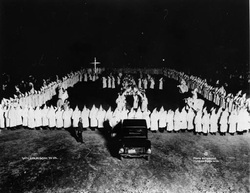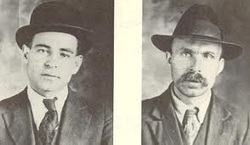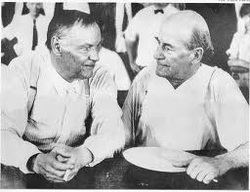Intolerance and Suspicion
Essential Question : How do attitudes towards immigration, blacks and other minorities reflect the intolerance of the decade? How does the nostalgia and attitudes from the past conflict with modern ideas of the decade?
Attitudes towards immigrants, blacks, and all minorities during the 1920's were very poor, and this reflected the intolerance of the decade, because it showed how most white Americans did not want any "new" immigrants coming into the country and taking jobs and money away from the public. There was also a lot of hatred to blacks, and the KKK was a leader of white supremacy and racial pride: Although not every person went to the extreme as the KKK did, there were many Americans who were racist, and did not like to see blacks progress the ways they did. These attitudes from the past conflicted with the ideas from the 1920's because things were changing very rapidly, and the American public had to get used to it.
Attitudes towards immigrants, blacks, and all minorities during the 1920's were very poor, and this reflected the intolerance of the decade, because it showed how most white Americans did not want any "new" immigrants coming into the country and taking jobs and money away from the public. There was also a lot of hatred to blacks, and the KKK was a leader of white supremacy and racial pride: Although not every person went to the extreme as the KKK did, there were many Americans who were racist, and did not like to see blacks progress the ways they did. These attitudes from the past conflicted with the ideas from the 1920's because things were changing very rapidly, and the American public had to get used to it.
Immigration Restriction

World War I revealed that the American Economy could function effectively without foreign immigration, and after the war, most immigrants had seemed to become "Americanized", so they were a part of American society and culture. However, after the war, there were many thoughts of new immigration restriction. Most of the arguments against immigration were economic reasons. One of the chief proponents of immigration restriction were leaders of the American Federation of Labor, because they feared wages would decline if unskilled immigrant workers flooded the labor market. A way immigrations was restricted was that in 1924, congress reduced the number of immigrants allowed into the U.S. each year to two percent of each nationality group counted in the 1890 census, and they also banned Asians entirely. Immigration laws all but eliminated the flow of immigrants from southern and eastern Europe. in the 1930's, just over a half million new immigrants entered the United States. Also during this time, Nativism was very strong, and with all of the immigration laws and restrictions, it was a victory to nativists who thought they could protect American culture and institutions by keeping out new and different people.
The KKK

The Ku Klux Klan was a very radical nativist group along with conflicts about rapid technological, economic, demographic, social, and cultural changes in the 1920's. Also, the KKK attempted to resist challenges to traditional morality by enlisting native, whtie, protestant Americans who portrayed morality, character, christian values, and "pure Americanism" During the 1920's the KKK stood for temperance and progressive reform organizations among other things. Also, they wanted to preserve the idealized "golden age" of American Life. The 1920's Klansmen focused on defending white, christian civilization, promoting community activities, enforcing morality, and fighting corruption and concentrated economic power. Finally, the 20's Klan was marked by a hatred of African Americans, and they had the ideals of white supremacy and wanted to maintain racial purity.
Red Scare and Palmer Raids

The
Red Scare was a nationwide fear of communists, socialists, anarchists, and
other dissidents, that suddenly grabbed the American psyche in 1919 following a
series of anarchist bombings. The
nation was gripped in fear. Innocent
people were jailed for expressing their views, civil liberties were ignored,
and many Americans feared that a Bolshevik-style revolution was at hand. Then,
in the early 1920s, the fear seemed to dissipate just as quickly as it had
begun, and the Red Scare was over. Two major examples of strikes that were included in the Red Scare were:
- Seattle Strike: general strike of all workers, they were labeled “Reds”. The mayor ended the strike, and proclaimed a victory for Americanism
- Boston Strike: Police force went on strike, afraid it was “Reds”, the mayor fired the whole police force
Strikes were "crimes against society," conspiracies against the government," and "plots to establish communism." In response to these Red Scares, the Palmer raids were conducted by Palmer and Hoover. They used the Sedition Act and Espionage Act to arrest people on suspiscion of being communist.
- Seattle Strike: general strike of all workers, they were labeled “Reds”. The mayor ended the strike, and proclaimed a victory for Americanism
- Boston Strike: Police force went on strike, afraid it was “Reds”, the mayor fired the whole police force
Strikes were "crimes against society," conspiracies against the government," and "plots to establish communism." In response to these Red Scares, the Palmer raids were conducted by Palmer and Hoover. They used the Sedition Act and Espionage Act to arrest people on suspiscion of being communist.
Sacco and Vanzetti Trial

Sacco and Vanzetti were Italians. They were accused of robbery of bank transport money and murder. The trial went on for over six weeks, where the themes of patriotism and radicalism were often debated by the prosecution and defense. Although neither Sacco nor Vanzetti had any previous criminal record, their political beliefs and ethnic backgrounds worked against them. In 1921, the jury found the two guilty of robbery and murder. They were long recognized by the authorities and
their communities as anarchist militants who had been extensively involved in
labor strikes, political agitation, and antiwar propaganda and who had had
several serious confrontations with the law. This trial went down as one of the most controversial trials in American history. Sacco and Vanzetti were executed in 1927.
Scopes Trial

The Scopes Trial was another very controversial trials in American history. The issue at hand was between evolution and creation being taught in public schools. The state of Tennessee passed a law prohibiting the teaching in public schools of any theories against human creation. John T. Scopes, a biology teacher, taught Darwinism in Dayton, Tennessee, which was a public school. Scopes was tried in 1925 for breaking the law. Clarence Darrow was one of Scopes's attorneys; William Jennings Bryan was the attorney for the other side. Darrow argued that academic freedom was being violated and claimed that the legislature had indicated a religious preference, violating the separation of church and state. He also maintained that the evolutionary theory was consistent with certain interpretations of the Bible, and in an especially dramatic session he sharply questioned Bryan on the latter's literal interpretation. In the end, Scopes was convicted for his teachings. Laws banning the teaching of evolution in public schools remained, but they were rarely enforced.
Thinking Like a Historian
Differing Perspectives : During the 1920's there were many changes for Blacks and immigrants. Also, there were many nativist groups who thought that there should be no more immigration into the United States, and that we should follow the beliefs of isolationism. Blacks were also looked down upon from many racist groups. However, both the immigrants and Blacks did not feel they should be treated this way, and tried to fight against it.


